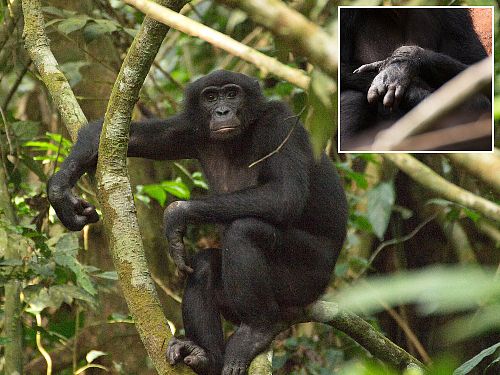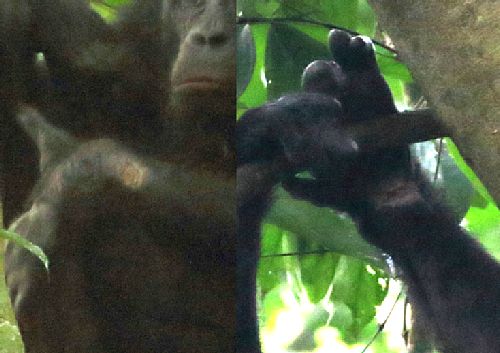|
<NOTE>
Published online (March 17, 2019)
Snare-related disability led to the near-fatal accident of a bonobo at Wamba, Democratic Republic of the Congo
Nahoko Tokuyama
Department of Evolutionary Studies of Biosystems, Sokendai, The Graduate University for Advanced Studies, Japan INTRODUCTION In places where their home-ranges overlap with humans, chimpanzees and bonobos are frequently caught in snares made from metallic wire (Kano 1984; Quiatt et al. 2002). Although the victims are generally able to free themselves by breaking the sapling to which the wire is connected, they often fail to remove the wire itself. It is often weeks to months before the wire drops off on its own or the limb of the victim rots where the wire tightens. Snare injuries may cause serious infections, which are sometimes fatal (Hashimoto 1999; Boesch & Boesch-Achermann 2000). Moreover, the victims often suffer from limb loss or deformation (Waller & Reynolds 2001). Here, I report a near-fatal (had he not been rescued by human observers) accident encountered by a male bonobo with snare-related limb disabilities. METHODS Bonobos have been studied at Wamba in the Luo Scientific Reserve of the Democratic Republic of Congo since 1973 (Kano 1992). Although the use of snares made from vines or nylon strings is allowed for subsistence hunting by local people, the use of snares made from a metallic wire is prohibited. However, metallic wire is easily available at the local market and some people use metallic snares because they trap animals more efficiently than traditional snares. Bonobos in PE group have been studied intensively since September 2010, though they had been sporadically studied earlier. On November 12, 2017, when this event was observed, PE group consisted of 27 individuals, including five adult males, nine adult females, and one adolescent female. The event was observed by trained local field assistants. Teams of two assistants followed the bonobos by working two shifts (morning and afternoon). I interviewed all four assistants in the evening that day. Gai was first identified as an adult male in PE group in 2007. His upper limbs were greatly deformed and exhibited typical effects of snare injuries (right: claw-hand and hooked-wrist, left: second to fourth digits missing from the second joint, Figure 1, Waller & Reynolds 2001). His left upper limb had been deformed before we first identified him in 2007. His right hand was trapped in a metallic wire in September 2009 and the wire did not drop off until November 2010 (T Sakamaki personal communication). The thumb and remaining parts of the four digits of his left hand were capable of a certain amount of movement, though clumsily. His right hand and wrist were stiff and unmovable. Although slower than other individuals, he could climb trees by holding the trunk using both of his arms. 
Area inside the white box shows his left hand from a different angle. OBSERVATIONS November 11, 2017 Two field assistants and I followed a large party of bonobos from 05:55 h. We observed all PE individuals, but lost them at 09:47 h due to heavy rain. November 12, 2017 The morning team of field assistants started searching for bonobos at 06:00 h and located them at 06:34 h. The bonobos had gathered at one place and were vocalizing loudly. The assistants soon noticed that Gai was stuck in a tree at a height of about 3 m. His left wrist was caught in a narrow gap where the tree trunk branched into two (Figure 2). The tree trunk and the two branches were about 20, 15, and 8 cm in diameter, respectively. Because his right hand was not capable of gripping, he could not lift his body high enough to free himself from the gap. There were multiple teeth marks on the branches (Figure 2) and the vines around him were bitten through. Judging from the fruits of Landolphia sp. scattered on the ground, the bonobos had fed there on the afternoon of November 11. No new night beds were found nearby. Gai seemed to be exhausted. The other bonobos were in the trees around Gai and making loud calls intermittently. At 06:34 h, when the assistants found the bonobos, an adult male (Snare) and three adult females (Bokuta, Maluta, and Nara) were sitting close to Gai and peering at him. At 06:47 h, an adult male (Malusu) approached Gai and threatened him by shaking branches and contest hooting. The other bonobos vocalized and Malusu stopped threatening Gai. At 07:00 h, an adult male (Turkey), two adult females (Saku and Marie), and a juvenile male (Hideo) approached Gai and peered at him. At 07:20 h, the field assistants judged that Gai could not get out from the gap by himself and they started cutting down the tree to rescue him. Two adult males (Turkey and Snare) approached and threatened the assistants by shaking branches and barking, and the field assistants scared the males off by shouting loudly. The entire party of bonobos moved several dozen meters away. At 07:24 h, the tree was cut down to the ground and Gai freed himself from the gap and ran away. At 07:34 h, the party of bonobos came back to where Gai had been caught. After one or two minutes, the bonobos moved about 50 m away and started resting and grooming on trees. All of the PE group individuals were observed there except for Gai. At 09:41 h, two adult males (Turkey and Ikura) and a juvenile male (Kale) moved to where Gai had been caught. At 09:43 h, an adult female (Marie) and a subadult female (Lucie) joined the males. At 09:44 h, all of the bonobos climbed down from the trees and started traveling. The field assistants followed the bonobos but lost them at 11:10 h because of their quick pace. At 14:15 h, the afternoon team of field assistants observed Gai walking alone on the ground. He fled from the assistants and was not observed again until December 2, 2017 (19 days). 
Field assistant, Iyokango Bahanande, demonstrates how Gai was trapped in the gap between the branches. Although the assistant is putting his right arm in the gap, Gai was trapped by his left arm. Teeth marks on the branches can be seen. December 2, 2017 Gai was observed in a party of PE group at 11:23 h. All individuals except Gai had been observed daily between November 12 and December 2, suggesting that Gai was ranging alone during this period. He had severe abraded wounds on the inside and outside of his left wrist (Figure 3) but showed no apparent signs of debility. 
Photos were taken on December 12, 30 days after the accident. DISCUSSION Based on indirect evidence, Gai might have been trapped in the gap of the branches when he was climbing down after eating Landolphia sp. on the afternoon of November 11. The branches could have been more slippery than usual because of heavy rain in the morning of that day. The teeth marks on the branches and chewed vines around him indicated that he had been struggling to free himself. He seemed to be already exhausted when the field assistants found him early in the morning on November 12. Without their rescue, Gai might have eventually died. After surviving the initial infection, snare injuries had been considered to give minimal effect on an individuals’ survival (Kano 1984, Stokes 1999). However, the current case shows that snare injuries can cause serious accidents even years after the original injury. It is important for researchers and governments to perceive the ongoing risk of snare injuries and make further effort to raise awareness in local communities. During the incident, the other group members gathered around Gai and were vocalizing loudly. Although they did not show any apparent behavior that would help Gai to free himself from the gap in the branches, some bonobos approached and peered at him. A male behaved aggressively toward Gai, but he stopped when other bonobos vocalized toward them. There were no night beds around Gai, which indicates that Gai spent the night of November 11 by himself. After Gai had become trapped, other bonobos might have left Gai in the afternoon of November 11 and then come back early in the morning of November 12. I have observed a very similar case in the same group in 2011 (Tokuyama et al. 2012). An adult male was caught in a snare. The other members of the party left him in the evening, but the next morning, they travelled back to where he had been trapped. Two possibilities are considered to be the motivation for bonobos re-visiting these injured individuals. First, bonobos might care about the injured or immobilized individuals. Although the bonobos leave the injured individuals to feed or to find appropriate bed sites, they might come back at a later time to check on the condition of the injured individuals. The other possibility is that bonobos just tend to be drawn to irregular events. Bonobos sometimes gather around trapped animals, dugout canoes that local people make in the forest, and so on. In such cases, bonobos often approach, peer, touch, and shake branches toward the objects (Hayashi et al. 2012; N Tokuyama personal observation). Bonobos also sometimes re-visit the place of an unusual event after a few hours or days (N Tokuyama personal observations). Although it is difficult to understand the motivation for bonobos re-visiting and gathering around Gai, this case may contribute to our insight into the behavioral characteristics and emotions of wild bonobos. ACKNOWLEDGMENTS I sincerely thank the field assistants for sharing their detailed account and precious information, as well as for rescuing Gai. I thank the Research Center for Ecology and Forestry and Ministry of Scientific Research, DRC for supporting my field research. I am also grateful to Dr. Tetsuya Sakamaki and Dr. Takeshi Furuichi for their information and discussions. I also thank Dr. Gaku Ohashi for his helphul comments and suggestions, and Dr. Kirsty Graham for proofreading my English writing. This study was financially supported by the Japan Society for the Promotion of Science Grant-in-Aid for JSPS Research Fellow (JP17J06911). REFERENCES Boesch C, Boesch-Achermann H 2000. The Chimpanzees of the Taï Forest: Behavioural Ecology and Evolution. Oxford University Press, New York. Hashimoto C 1999. Snare injuries of chimpanzees in the Kalinzu Forest, Uganda. Pan Afr News 6: 20–22. https://doi.org/10.5134/143377 Hayashi M, Ohashi G, Ryu H 2012. Responses toward a trapped animal by wild bonobos at Wamba. Anim Cogn 15: 731–735. https://doi.org/10.1007/s10071-012-0478-x Kano T 1984. Observations of physical abnormalities among the wild bonobos (Pan paniscus) of Wamba, Zaire. Am J Phys Anthropol 63: 1–11. https://doi.org/10.1002/ajpa.1330630102 Kano T 1992. The Last Ape: Pygmy Chimpanzee Behavior and Ecology. Stanford University Press, Stanford. Quiatt D, Reynolds V, Stokes EJ 2002. Snare injuries to chimpanzees (Pan troglodytes) at 10 study sites in east and west Africa. Afr J Ecol 40: 303–305. https://doi.org/10.1046/j.1365-2028.2002.00356.x Stokes EJ 1999. Feeding Skills and the Effect of Injury on Wild Chimpanzees. PhD theis, Universty of St. Andrews, St. Andrews. Tokuyama N, Emikey B, Bafike B, Isolumbo B, Iyokango B, Mulavwa MN, Furuichi T 2012. Bonobos apparently search for a lost member injured by a snare. Primates 53: 215–219. https://doi.org/10.1007/s10329-012-0298-2 Waller JC, Reynolds V 2001. Limb injuries resulting from snares and traps in chimpanzees (Pan troglodytes schweinfurthii) of the Budongo Forest, Uganda. Primates 42: 135–139. https://doi.org/10.1007/BF02558140 Received: 31 January 2019 Accepted: 12 March 2019 Back to Contents |